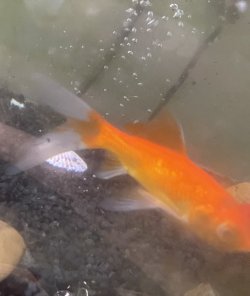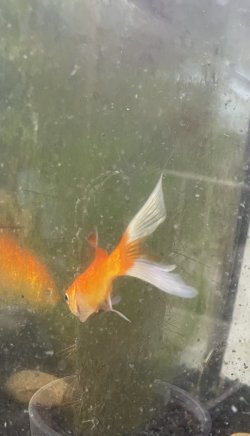Recently got a new Goldfish yesterday noticed a rip on his Fin my older goldfish doesn’t have it. I did take out the big rock that was originally there just in case. I’ve tested for nitrate and ammonia and they’re fine. Any ideas?
You are using an out of date browser. It may not display this or other websites correctly.
You should upgrade or use an alternative browser.
You should upgrade or use an alternative browser.
Torn fin or Fin Rot?
- Thread starter R3mma17
- Start date
It just looks like a rip in the fin but its hard to see much else due to the glass being dirty.
The best treatment for damaged fins is clean water. Do a 75% water change and gravel clean the substrate every day for a week. That should keep the water clean so the fish can heal itself.
Make sure any new water is free of chlorine/ chloramine before it's added to the tank.
Monitor the fins. If they get red lines in them or go white and fluffy where the damage is, that's an issue. The red lines indicate bacteria, the white fluffy is excess mucous or fugus. Salt can treat both of these if used early enough but probably isn't required for this issue now.
--------------------
SALT
You can add rock salt (often sold as aquarium salt), swimming pool salt, or any non iodised salt (sodium chloride) to the aquarium at the dose rate of 1 heaped tablespoon per 20 litres (5 gallons) of water. If there is no improvement after 48 hours you can double that dose rate so there is 2 heaped tablespoons of salt per 20 litres.
Keep the salt level like this for 1 to 2 weeks.
The salt will not affect the beneficial filter bacteria, fish, plants, shrimp or snails.
After you use salt and the fish have recovered, you do a 10% water change each day for a week using only fresh water that has been dechlorinated. Then do a 20% water change each day for a week. Then you can do bigger water changes after that. This dilutes the salt out of the tank slowly so it doesn't harm the fish.
If you do water changes while using salt, you need to treat the new water with salt before adding it to the tank. This will keep the salt level stable in the tank and minimise stress on the fish.
When you first add salt, add the salt to a small bucket of tank water and dissolve the salt. Then slowly pour the salt water into the tank near the filter outlet. Add the salt over a couple of minutes.
The best treatment for damaged fins is clean water. Do a 75% water change and gravel clean the substrate every day for a week. That should keep the water clean so the fish can heal itself.
Make sure any new water is free of chlorine/ chloramine before it's added to the tank.
Monitor the fins. If they get red lines in them or go white and fluffy where the damage is, that's an issue. The red lines indicate bacteria, the white fluffy is excess mucous or fugus. Salt can treat both of these if used early enough but probably isn't required for this issue now.
--------------------
SALT
You can add rock salt (often sold as aquarium salt), swimming pool salt, or any non iodised salt (sodium chloride) to the aquarium at the dose rate of 1 heaped tablespoon per 20 litres (5 gallons) of water. If there is no improvement after 48 hours you can double that dose rate so there is 2 heaped tablespoons of salt per 20 litres.
Keep the salt level like this for 1 to 2 weeks.
The salt will not affect the beneficial filter bacteria, fish, plants, shrimp or snails.
After you use salt and the fish have recovered, you do a 10% water change each day for a week using only fresh water that has been dechlorinated. Then do a 20% water change each day for a week. Then you can do bigger water changes after that. This dilutes the salt out of the tank slowly so it doesn't harm the fish.
If you do water changes while using salt, you need to treat the new water with salt before adding it to the tank. This will keep the salt level stable in the tank and minimise stress on the fish.
When you first add salt, add the salt to a small bucket of tank water and dissolve the salt. Then slowly pour the salt water into the tank near the filter outlet. Add the salt over a couple of minutes.
The tail is looking much better now thank you, I've been doing water changes regularly and it's completely healed. My only other problem that's started is both fish seem to rub against each other and give each other some "bites" it's not doing them any damage but i don't want either to be stressed out. They don't do it a lot but it still concerns me when i see it. I don't know if it's breeding signs or something of the sort but it's rather stressful to watch for some reason.It just looks like a rip in the fin but its hard to see much else due to the glass being dirty.
The best treatment for damaged fins is clean water. Do a 75% water change and gravel clean the substrate every day for a week. That should keep the water clean so the fish can heal itself.
Make sure any new water is free of chlorine/ chloramine before it's added to the tank.
Monitor the fins. If they get red lines in them or go white and fluffy where the damage is, that's an issue. The red lines indicate bacteria, the white fluffy is excess mucous or fugus. Salt can treat both of these if used early enough but probably isn't required for this issue now.
--------------------
SALT
You can add rock salt (often sold as aquarium salt), swimming pool salt, or any non iodised salt (sodium chloride) to the aquarium at the dose rate of 1 heaped tablespoon per 20 litres (5 gallons) of water. If there is no improvement after 48 hours you can double that dose rate so there is 2 heaped tablespoons of salt per 20 litres.
Keep the salt level like this for 1 to 2 weeks.
The salt will not affect the beneficial filter bacteria, fish, plants, shrimp or snails.
After you use salt and the fish have recovered, you do a 10% water change each day for a week using only fresh water that has been dechlorinated. Then do a 20% water change each day for a week. Then you can do bigger water changes after that. This dilutes the salt out of the tank slowly so it doesn't harm the fish.
If you do water changes while using salt, you need to treat the new water with salt before adding it to the tank. This will keep the salt level stable in the tank and minimise stress on the fish.
When you first add salt, add the salt to a small bucket of tank water and dissolve the salt. Then slowly pour the salt water into the tank near the filter outlet. Add the salt over a couple of minutes.
Post a video of the fish rubbing against each other. You can upload videos to YouTube, then copy & paste the link here.
If you use a mobile phone to film the fish, hold the phone horizontally (landscape mode) so the footage fills the entire screen and doesn't have black bars on either end.
What's the temperature of the water?
How big are the fish?
Have you added anything new to the tank in the last 2 weeks?
The extra water changes might have stimulated them into breeding if the temperature is warm enough (above 18C).
If you added new fish recently, they might have introduced an external protozoan parasite like white spot, Costia, Chilodonella or Trichodina. White spot will appear as small white dots (about the size of a grain of salt) sprinkled over the body and fins and can be treated with Malachite Green or copper (Malachite Green is a bit safer but not much). Male goldfish will develop small white bumps on their gill covers and the edge of their pectoral (side) fins when in breeding condition so don't mistake a male in breeding condition for a fish with white spot.
The other 3 external protozoa (Costia, Chilodonella & Trichodina) cause the fish to develop cream, white or grey patches on part or parts of the body. These 3 parasites can be treated with salt (2 heaped tablespoons of salt per 20 litres of water for 2 weeks).
If you use a mobile phone to film the fish, hold the phone horizontally (landscape mode) so the footage fills the entire screen and doesn't have black bars on either end.
What's the temperature of the water?
How big are the fish?
Have you added anything new to the tank in the last 2 weeks?
The extra water changes might have stimulated them into breeding if the temperature is warm enough (above 18C).
If you added new fish recently, they might have introduced an external protozoan parasite like white spot, Costia, Chilodonella or Trichodina. White spot will appear as small white dots (about the size of a grain of salt) sprinkled over the body and fins and can be treated with Malachite Green or copper (Malachite Green is a bit safer but not much). Male goldfish will develop small white bumps on their gill covers and the edge of their pectoral (side) fins when in breeding condition so don't mistake a male in breeding condition for a fish with white spot.
The other 3 external protozoa (Costia, Chilodonella & Trichodina) cause the fish to develop cream, white or grey patches on part or parts of the body. These 3 parasites can be treated with salt (2 heaped tablespoons of salt per 20 litres of water for 2 weeks).
Similar threads
- Replies
- 54
- Views
- 4K
- Replies
- 10
- Views
- 436




